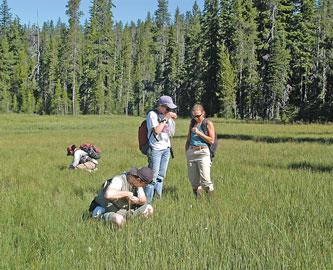Little-visited Sphagnum Bog a hotbed for botanists
Herald and News
Klamath Falls, Oregon
August 6, 2007
BY LEE JUILLERAT
Boggled and bogged down in the bog.
Larry Powers led a group of nine through a section of bogs recently at Sphagnum Bog, a little-visited, remote research natural area near the northwest boundary of Crater Lake National Park.
 |
| H&N photo by Lee JuilleratAlina Campbell, Dave Kofranek, Sarah Malaby and Jeanne Skalka study plants in Sphagnum Bog. |
Powers, a professor of natural sciences at Oregon Institute of Technology, is spending the summer as the science coordinator for the park’s new Science and Learning Center.
“My job is to encourage scientific research,” Powers said.
He and botanists from around the state are focusing on studying Sphagnum Bog, about 770 acres of open bogs, or spongy ground characterized by decaying mosses, in a 1,200-acre area.
‘Bio-Blitz’
The trip was the second of three “Bio-Blitz” trips where volunteers are helping to identify, photograph and catalog plants, flowers and mosses found in the bog.
“We’re hoping to really go ahead and get a good inventory and get good baseline data,” Powers said, noting the only other prior research involved a study done 30 years ago and unpublished work done last year by an Oregon State University graduate student.
“Part of this is just plain curiosity. I’m curious as to what’s out here.”
Last week’s Bio-Blitz included several botanists and two moss specialists. Because of the size of bog, Powers focused on bogs in the north and east sections. During an earlier Bio-Blitz, formally known as Citizens for Science Bio-Blitz, session volunteers identified about 160 species.
“I’m hoping before everything’s said and done, we’ll end up with 200,” Power said, noting long-range plans include publishing a field guide.
Most of the plants and flowers aren’t the garden-sized varieties. Jeanne Skalka and Sarah Malaby, botanists with the Fremont-Winema National Forests Klamath Falls office, identified tiny plants that demanded specialized knowledge. In sections of bogs that had not been visited on the previous tour, Powers asked that all findings be called out so he and Alina Campbell, a botanist who is spending the summer at Lava Beds National Monument, could record their findings.
As Skalka, Malaby and other botanists, Richard Helliwell from the Umpqua National Forest, Dave Kofranek from Eugene, and Bob Meinke and Kelly Amberry, both from Oregon State University, called out their findings with Latin names, the effect was a scene out of a Harry Potter book or movie, with wizards shouting off enchantments” “Eleocharis!”, “Carex lanuginosa!” “Plananthera leucostachy!”
There were also flowers and plants better known to backyard gardeners, including asters, louseworts, sundews, sedges, monkshood, fireweed and, best of all, bog blueberries. Unlike many plants that found their way into plastic and paper bags for further identification, the blueberries were greedily swallowed.
For Helliwell and Kofranek, the outing was especially productive. Both are versed in identifying mosses.
Although named a bog, Powers said the area is technically a fen. A fen, he explained, has water moving through it while a bog is an area of stagnant water.
Although future Bio-Blitzes will be open to the public, with volunteers of all ages and backgrounds, this year’s trips into Sphagnum Bog are being controlled because the bogs won’t take too much impact.
After the two-mile hike from the trailhead on the Rogue River National Forest that quickly entered the park to the bog, team members swapped their hiking boots for tennis shoes and other less impacting footwear. The bog walk often included squishy tramps through ankle deep swamps that occasionally bogged down walkers.
But Powers and the team were happily boggled by the rich findings, which also included springs, garter snakes, tiny frogs and views of the effervescently bubbling Crater Creek.
Kofranek happily flopped in the bog while taking samples of mosses for up-close investigations with a jeweler’s glass.
“There’s no place I’d rather be,” he said.
– By Lee Juillerat
***previous*** — ***next***

